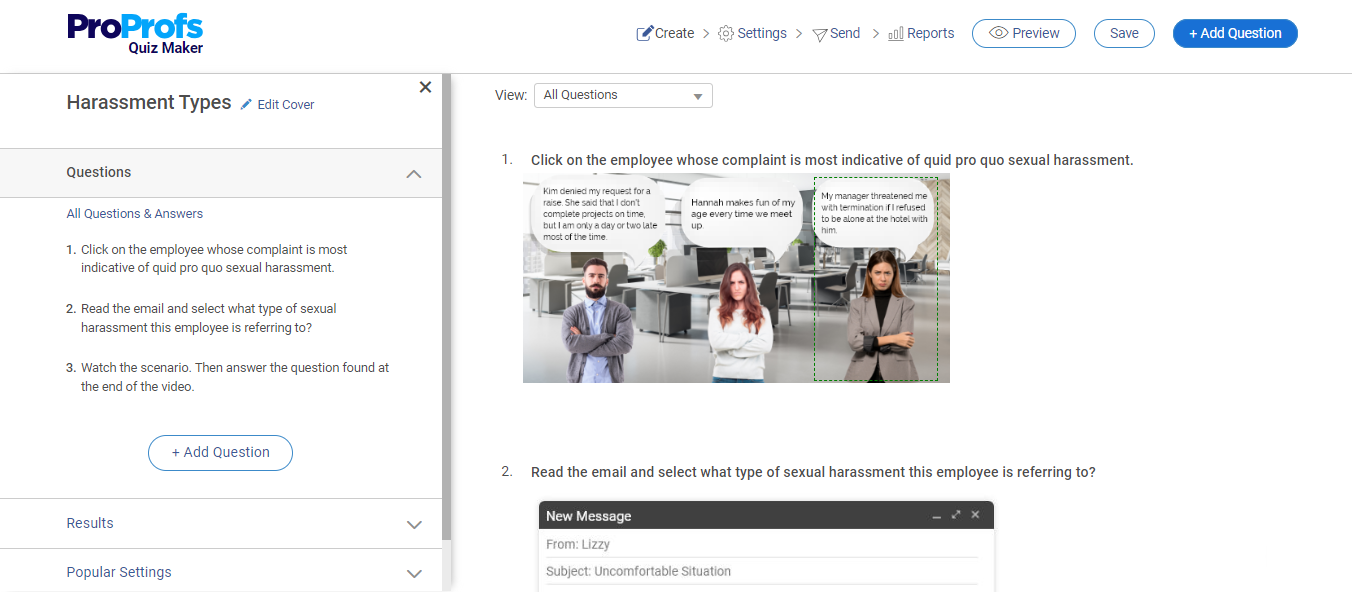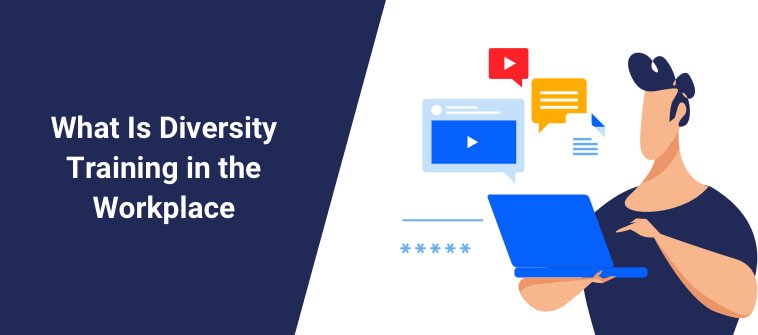Imagine stepping into an office where every employee feels valued, heard, and safe from harassment. This isn’t just an ideal situation; it’s what POSH (Prevention of Sexual Harassment) training aims to achieve.
As incidents of workplace harassment continue to surface, the urgency of such education has never been more apparent.
In this guide, we’ll explore what POSH training is, its benefits, what it covers, modes of delivery, how to develop such a program and some example courses.
Read on to understand how empowering your team with the right knowledge isn’t just about compliance — it’s about building a workplace where everyone can thrive.
What Is POSH Training?
POSH training refers to the prevention of sexual harassment training. This type of training educates employees about sexual harassment, its implications, and the mechanisms to address it. The objective is to create a safe and respectful work environment for everyone.
In other words, the training raises awareness among employees about
- what constitutes sexual harassment
- the legal framework
- company policies
- preventive measures
- handling complaints
- creating a supportive environment
What Are the Benefits of POSH Training for Employees?
POSH training programs are essential in today’s workplace to create a safe and inclusive environment for all employees. This training not only helps in complying with legal requirements but also fosters a culture of respect and dignity.
Here are the key benefits of POSH training for employees:
- Legal Compliance
POSH training ensures that both organizations and their employees are aware of the laws regarding workplace harassment. In many regions, such training is legally mandated.
By educating employees about what constitutes sexual harassment and the repercussions of such behavior, organizations can avoid legal liabilities and maintain a law-abiding workplace. - Prevention of Harassment
Knowledge is a powerful tool in prevention. Through POSH training, employees learn to recognize the signs of harassment and understand the impact of their actions.
This awareness is crucial in preventing harassment, as employees are more likely to think twice about their conduct. Preventive education leads to a significant reduction in incidents, contributing to a safer work environment.
“Training is a powerful way for employers to reduce instances of sexual harassment by establishing shared norms and improving understanding about the type of conduct that is acceptable in the workplace.” – Ally Coll, President & Co-founder, the Purple Campaign - Promotion of a Supportive Work Culture
POSH training promotes a culture of support and empowerment. It encourages employees to speak up against harassment without fear of retaliation.
By establishing clear procedures for reporting and addressing complaints, the training assures employees that their concerns will be taken seriously and handled appropriately. This openness fosters trust and improves morale among team members.
- Enhanced Employee Well-Being
Employees who feel safe and respected at work are likely to be more productive and engaged. POSH training contributes to an atmosphere where individuals feel valued and protected.
This sense of security can enhance overall employee well-being, reducing stress and increasing job satisfaction.
- Improved Corporate Image
Organizations that prioritize POSH training are often viewed as ethical and responsible. This can enhance their reputation not only among potential employees but also customers and business partners.
A strong stance against harassment reflects positively on the company’s values and can influence business success positively.By incorporating POSH awareness training, organizations can comply with legal standards and take significant steps toward nurturing a respectful, inclusive, and productive work environment.
Case Study
The Kelley Williamson case, resolved by the U.S. Equal Employment Opportunity Commission (EEOC), is an example of workplace sexual harassment and the crucial role of employer intervention and training in addressing such issues.
Overview of the Case
Kelley Williamson, a gas station and convenience store operator in Illinois, was involved in a lawsuit after a female employee reported enduring months of sexual harassment by a male customer. The harassment included frequent sexual advances and crude jokes. Despite the employee’s complaints, Kelley Williamson’s management initially failed to take adequate steps to stop the harassment.
Legal Action and Settlement
The case was escalated to the EEOC after the internal complaint mechanism did not resolve the issue. The EEOC’s investigation led to a lawsuit, which concluded with a consent decree.
Under the terms of the settlement, Kelley Williamson agreed to pay $75,000 to the victim. More importantly, the decree included provisions for the company to enhance its training programs regarding Title VII of the Civil Rights Act and the Americans with Disabilities Act (ADA).
This training was mandated to ensure all employees and managers were aware of the legal requirements and company policies regarding harassment and discrimination.
Implications for Training and Policy Development
As a part of the consent decree, Kelley Williamson was required to develop or revise its policies to prevent and correct instances of sexual harassment. The company was also mandated to conduct training sessions that not only covered the legal aspects of Title VII and the ADA but also focused on practical measures for handling harassment complaints effectively.
This case underscores the importance of proactive training that empowers employees to recognize and report harassment and equips managers with the tools needed to respond promptly and effectively.
EEOC’s Role and Monitoring
The EEOC was tasked with monitoring the company’s compliance with the consent decree for four years. This oversight was intended to ensure that Kelley Williamson adhered to the agreement and made the necessary improvements to its workplace policies and training programs.
This case highlights the critical need for employers to maintain robust harassment prevention policies and to provide thorough training to all employees. It also illustrates the role of regulatory bodies like the EEOC in enforcing workplace laws and protecting employee rights.
Comply with POSH guidelines in your workplace
Simplify sexual harassment prevention training.
What Does POSH Training Cover?
A standard POSH training program typically covers various topics to ensure that the workplace remains compliant with legal standards and supportive of all employees.
Here’s a quick look at them:
- Definitions and Examples: This section educates participants on what constitutes sexual harassment, including verbal, non-verbal, and physical behaviors. It usually includes relatable examples and scenarios.
- Legal Framework: An overview of the local, state, and federal laws and regulations regarding workplace harassment. For more on this, read this guide.
- Organizational Policies: Detailed review of the organization’s anti-harassment policy and the specific duties of employers and employees in preventing and responding to incidents.
- Prevention Strategies: Strategies to promote respect and inclusion by preemptively addressing behaviors that could lead to harassment. Learners are taught how to recognize signs of inappropriate behavior, how to intervene safely, and how to support someone who may be targeted by such behavior.
- Reporting Mechanisms: How to report harassment, both formally through designated channels and informally through discussion. Training on reporting also makes it clear how complaints are handled discreetly and without retaliation.
- Handling Complaints: Steps for a fair and thorough investigation of harassment allegations, criteria for determining the outcome of an investigation, and appropriate disciplinary actions.
- Legal & Ethical Implications: This topic discusses the potential legal consequences of non-compliance for individuals and organizations. It also emphasizes the significance of understanding the broader ethical impact of harassment on victims and the workplace culture.
These topics are designed to ensure that employees and supervisors are well equipped with legal requirements and lead by example in maintaining a respectful and safe environment.
What Are the Modes of Delivering POSH Awareness Training?
There are different ways to deliver POSH training, depending on your preference, convenience, and training budget.
Here are some common methods:
- In-Person: This traditional classroom format is characterized by face-to-face interactions. Examples include workshops, seminars, role-plays, group discussions, and direct feedback from trainers. This method can be highly engaging and effective for complex and sensitive topics like sexual harassment.
- Online Training Modules: Online POSH training for employees is a flexible and scalable option that allows participants to complete training at their own pace. Online modules can include courses, video presentations, quizzes, and interactive scenarios. This mode is particularly useful for organizations with employees in multiple locations.

- Webinars: Live webinars offer real-time interaction with trainers via the internet. Participants can ask questions and engage in live discussions. Webinars can also be recorded for later viewing, offering flexibility in training schedules.
- Hybrid Training: By combining in-person and online elements, hybrid training can accommodate diverse learning preferences and logistical needs. Such blended learning strategies can be particularly effective in training local and remote employees.
- On-the-Job Training: This involves more informal training methods, such as coaching or mentoring, directly in the workplace. It is useful for reinforcing POSH policies through regular, everyday interactions.When choosing a mode for delivering POSH training, consider:
- the number of learners you need to train
- geographical distribution of employees
- multilingual needs
- engagement and interaction levels
- the frequency of the training program
- budget and resources
Choosing the right training mode involves balancing these factors with your organization’s specific needs to ensure optimal outcomes.
Get Free Employee Training Software — All Features, Forever.
We've helped 567 companies train 200,000+ employees. Create courses in under a minute with our AI LMS or use 200+ ready-made courses on compliance, harassment, DEI, onboarding, and more!
How to Develop a POSH Training Program
Here’s a step-by-step guide for creating a structured, efficient, and impactful POSH training program for employees.
Step 1: Understand Legal Requirements
Start by familiarizing yourself with local and national laws regarding workplace harassment. Develop or update your organization’s anti-harassment policy to align with these legal standards.
Step 2: Define Training Objectives
Make sure that the training educates employees about what constitutes sexual harassment, the consequences of harassment, and the rights of the employees. Focus on how to prevent occurrences of harassment through behavioral change and awareness. Teach employees and especially managers how to respond effectively if they witness or experience harassment.
Step 3: Select the Right Tool and Courses
Use online training platforms, such as a learning management system (LMS), that are proven to be more flexible, scalable, and effective than traditional lecture-based formats.
Similarly, choose quality sexual harassment training courses that are accredited by reputable organizations or at least developed by industry experts to ensure the training meets high standards.
These tools and courses should be easily tailored to your organization’s specific needs and culture. Only then can you address the actual challenges employees face. This will increase the likelihood of willingness to participate and information retention.
Step 4: Roll Out the Training
The next step is training implementation. But before full deployment, pilot-test the training with a small group of employees to gather initial feedback and make necessary adjustments.
Roll out the training in phases rather than all at once. Start with leadership and management teams, followed by different departments or units. This approach helps manage resources effectively and allows for adjustments between phases.
Develop a comprehensive communication plan to inform employees about the training objectives, schedule, and expectations. Clear communication helps increase participation rates and ensures employees are prepared and understand the importance of the training.
Step 5: Monitor and Evaluate the Training
Implement a robust feedback mechanism to gather insights from employees on the training’s effectiveness and areas of improvement. Use pre-training and post-training assessments to measure knowledge gains and behavior changes. Track participation and completion rates to ensure compliance and engagement. Watch: How to Create an Assessment Online
Step 6: Conduct Regular Updates and Refreshers
Mandate annual refresher courses to keep the knowledge fresh and address any new issues or changes in the law. Encourage continuous learning by providing access to resources like articles, videos, and case studies related to POSH.
Step 7: Foster an Open Culture
This is a vital part of every POSH awareness training initiative.
Create an environment where employees feel safe to report incidents without fear of retaliation. Establish clear support systems, including confidential counseling and a responsive complaint mechanism.
By carefully following these steps, you can easily see successful POSH programs in action and remove any possible hurdles.
Online POSH Training Programs for Employees
Just as selecting the right LMS is crucial for delivering impactful training, choosing the appropriate POSH courses is key for successful learning.
In the following section, we will explore a few examples of training programs that are designed to meet the needs of ongoing compliance training.
1. Federal Sexual Harassment Training Course
This course is designed by legal experts for employees and supervisors at all levels within the United States. It includes chapters on federal and state regulations related to workplace sexual harassment. You’ll also find real-life scenarios to strengthen your understanding of the topic. Following the course, participants will be able to recognize and address incidents of sexual harassment.
2. CA Sexual Harassment Training for Employees
With this sexual harassment training course, your employees can stay compliant with federal and California sexual harassment laws, regardless of the job position or industry. It’s based on state-mandated requirements for businesses with five or more employees.
3. New York Sexual Harassment Training Course
Deploy this NYS sexual harassment training course designed by legal professionals to train employees on federal and NYS laws. The course is meant for employees working in the state at all levels. You may use the course as-is or customize it to fit your unique requirements, such as your company’s harassment policies.
4. Chicago Sexual Harassment Training Course for Employees
This course complies with the federal and Illinois sexual harassment training requirements. It can help you tackle any form of harassment and discrimination in the workplace. It includes an introduction to sexual harassment, types of sexual harassment, what to do if one is sexually harassed, retaliation, and reporting.
5. Canada Sexual Harassment Prevention Training
Sexual harassment training in Canada is governed by federal, provincial, and territorial laws. They include the Criminal Code, the Canadian Human Rights Act (CHRA), the Canada Labour Code, and other regulations. This course meets all these federal and provincial requirements, and you can deploy it to build a respectful & harassment-free workplace.
Build a Safe, Respectful & Inclusive Culture With POSH Training
In summary, POSH training is the key to a safe and inclusive work environment. It educates employees about the ugly side of sexual harassment and how they can play a role in preventing or addressing it.
You’ve seen what the training looks like and its benefits. You’ve also seen what the training generally covers, the modes of delivering it, and how to implement it.
Armed with this knowledge, the next ideal step would be to deploy such a program in your organization using a robust cloud LMS like ProProfs Training Maker. This easy-to-use platform comes with professionally designed, fully customizable, and ready-to-use courses on in-demand topics, including sexual harassment prevention training. So, it’s easy to get started.
Remember, POSH training is invaluable in promoting a healthy, respectful, ethical, inclusive, and legally compliant workplace. Only by conducting the training on time can everyone remain responsible and accountable.
 Tips
Tips
We’d love to hear your tips & suggestions on this article!
Get Free Employee Training Software — All Features, Forever.
We've helped 567 companies train 200,000+ employees. Create courses in under a minute with our AI LMS or use 200+ ready-made courses on compliance, harassment, DEI, onboarding, and more!

 We'd love your feedback!
We'd love your feedback! Thanks for your feedback!
Thanks for your feedback!







